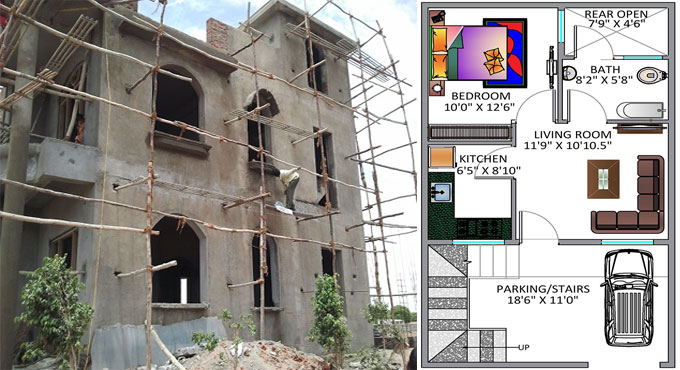
Standard 2BHK Flat RCC Design And Calculation
Today, let us design an average plan of a general 2BHK apartment. What's more, we should just take dead and live loads. Include wind loads and seismic loads as indicated by zone in the wake of rehearsing with dead and live load.
The thought is basic ? Slab lays on beams. Beams lay on columns and Columns lay on footings. So design slab first, at that point utilize the load from load to design beams. Beams will put load on columns. Also, columns on footings.
Essentials:
Architectural drawing
IS codes ? 456, 875 (I and II)
Soil report
Logical mini-computer (A scientific calculator will suffice)
MS Excel ? for quicker counts. Many design workplaces use Excel format sheets. Try not to consider them to be designing programming. They are only for quicker computations and limit blunders.
We should begin the RCC design and calculations now.
Design Plan:
1. Imprint columns.
2. Join columns to check essential beams. There will be tertiary beams laying on essential beams.
3. Imprint all beams. Number them.
4. Presently mark slabs. Slabs with comparative measurements will be denoted the equivalent.
5. Design slabs. Use loads from IS:875 section 2, call it 'w'. Discover the depth and territory of steel. We'll do enumerating later.
6. Presently beams will be determined each separately. To begin with, how about we figure for tertiary beams, i.e beams laying on different beams. Accept, the depth and width of all beams are 500 mm and 300 mm individually. Draw power dia for each beam.
Slab load: For two way slab ? load on beam of length 'l' = WL/3. Ascertain slab load force for every one of the 4 beams on which 2 way slab is resting. Units in KN/m (UDL). For one way slab 'WL/2' for the beams supporting the slab.
Wall Load Intensity: The density of the wall is 18 KN/m3. Duplicate by height of wall and thickness of wall. Expect wall height 2.5m and width 300mm for outer and 230 mm for inner. Duplicate by 1.5 (factor of wellbeing). Presently wall power is in units KN/m (UDL).
Concrete Weight
Formula:
Weight of concrete = Self-weight x Density (25KN/m3)
Now, Self-weight = Width of beam x Height of beam
= 500 mm x 300 mm
= 0.5 m x 0.3 m
Therefore, Weight of concrete
= 25 x 0.5 x 0.3
= 3.75 x 1.5
= 5.62 KN/m
(Where 1.5 is a factor of security, or safety margin)
Include these calculations in your design. That is your net UDL. Discover second and response powers at help.
For essential beams rehash a similar procedure. Be that as it may, presently include the responses of tertiary beams as point loads at concurring separation. At that point, Use Substitute edge examination to compute range minutes and bolster minutes. At the same time ascertain responses at bolsters. Discover the zone of steel at top and base.
Columns: Assume measurements 500 mm x 300 mm. Use minutes and responses from beams laying on columns to discover the zone of steel. Remember to include the column's self-weight. Net load from columns will be utilized to design footings.
Enumerating: Detailing of steel will be according to SP 34 codes.
This concludes the design of a standard 2BHK flat RCC design.


